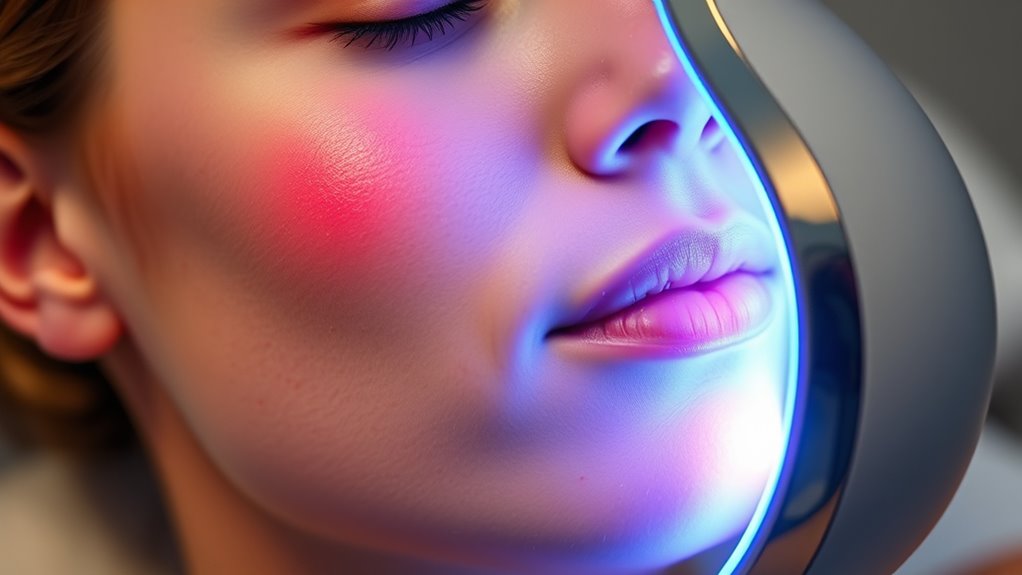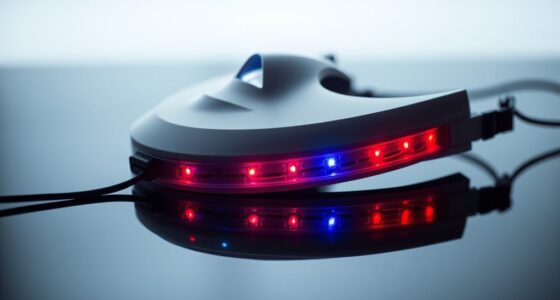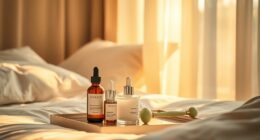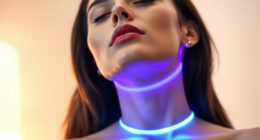To effectively combat breakouts with LED therapy, consider customizing your treatment with specific blue and red wavelengths that target bacteria and inflammation. Consistent sessions, ideally guided by a skincare professional, can boost medication outcomes, reduce redness, and promote healing. Adjusting device settings based on your skin’s response guarantees better results over time. If you want to learn more about making LED therapy work for your skin, keep exploring these proven strategies.
Key Takeaways
- Customizable LED panels with blue and red wavelengths target bacteria and inflammation for personalized acne treatment.
- Combining blue and red light enhances overall skin clarity by addressing multiple acne causes simultaneously.
- LED therapy boosts medication effectiveness, reduces redness, and may allow lower medication doses.
- Proper scheduling and professional guidance optimize treatment results and ensure safe, consistent sessions.
- LED therapy is a safe, non-invasive option that, when combined with skincare routines, promotes clearer, healthier skin.

If you’re struggling with acne, LED therapy offers a promising, non-invasive treatment option. One of the key advantages is the ability to customize LED panels to suit your specific skin needs. LED panel customization allows practitioners to select particular wavelengths, intensities, and treatment durations tailored to your skin type and acne severity. This targeted approach ensures you’re not wasting time or exposing your skin to unnecessary light, maximizing the therapy’s effectiveness. For example, blue light, which penetrates the skin’s surface, effectively kills acne-causing bacteria, while red light reduces inflammation and promotes healing. By customizing the LED panel, your skincare professional can combine these wavelengths to address multiple aspects of acne simultaneously, leading to faster and more noticeable results.
Customizable LED panels target acne more effectively by combining specific wavelengths for faster, clearer skin.
Another important aspect of successful LED therapy is how it works alongside your existing acne medication regimen. When used in synergy with topical or oral medications, LED therapy can enhance their effectiveness. For instance, treatments like benzoyl peroxide or retinoids work to reduce oil production and prevent clogged pores, but they can sometimes cause irritation. Red and blue LED light can soothe inflamed skin and reduce redness, making your medication more tolerable and effective. Additionally, LED therapy can improve skin penetration, helping medications reach deeper layers where bacteria and oil glands reside. This synergy means you might use lower doses of medications, decreasing potential side effects while still achieving clear skin.
Implementing LED therapy as part of your acne treatment plan involves coordination between you and your skincare provider. They will likely assess your skin, discuss your medication use, and design a customized LED treatment schedule. During these sessions, your provider may adjust the LED panel settings based on your progress, ensuring you’re getting the ideal combination of wavelengths and treatment frequency. Consistency is key, so following the prescribed schedule will help you see results sooner.
Furthermore, LED therapy is gentle and safe, making it suitable for long-term use without notable side effects. When combined with a thorough skincare routine, including medications, proper cleansing, and moisturization, it can greatly improve your skin’s appearance. Keep in mind, though, that individual results vary, and patience is essential. By leveraging LED panel customization and understanding how it can work with your acne medications, you’re taking a proactive step toward clearer, healthier skin. With persistence and the right professional guidance, LED therapy can become a powerful component of your acne-fighting arsenal.
Frequently Asked Questions
Are LED Treatments Safe for Sensitive Skin Types?
Yes, LED treatments are generally safe for sensitive skin when used correctly, but you should always check LED safety guidelines. If you have sensitive skin, consult a dermatologist before trying LED therapy to verify it’s suitable for your skin type. Start with a gentle setting and monitor how your skin reacts. Proper use minimizes risks of irritation, making LED therapy a safe option for many with sensitive skin.
How Long Does Each LED Therapy Session Typically Last?
You’ll find that each LED therapy session lasts about 20 to 30 minutes, which is just enough time for your skin to soak up all those beneficial rays. Ironically, the real challenge isn’t the session length but sticking to the recommended treatment frequency—usually once or twice a week. Consistency is key, so set a schedule and watch your skin improve without wasting your precious time.
Can LED Therapy Be Combined With Other Acne Treatments?
Yes, you can combine LED therapy with other acne treatments. Combining treatments, or therapy integration, often enhances results and speeds up recovery. You might use topical medications alongside LED sessions or incorporate oral antibiotics, but always consult your dermatologist first. They’ll tailor a treatment plan that safely integrates therapies, ensuring you get the best possible outcome without irritating your skin or causing adverse reactions.
What Are the Potential Side Effects of LED Acne Therapy?
You might experience some potential skin irritation after LED acne therapy, though it’s usually mild and temporary. To safeguard your eyes, make sure to wear appropriate eye safety gear during treatment, as the light can be intense. Rarely, individuals may develop redness or sensitivity, but these side effects typically resolve quickly. Always follow your provider’s instructions to minimize risks and ensure safe, effective results.
How Often Should I Undergo LED Therapy for Best Results?
You should undergo LED therapy 2-3 times a week for the best results, like fueling a steady fire that keeps your skin glowing. Focus on treatment frequency and ideal scheduling to see consistent improvements. Overdoing it might irritate your skin, so stick to a routine recommended by your dermatologist. Consistency is key—regular sessions will help reduce breakouts and give you clearer, healthier skin over time.
Conclusion
Incorporating LED therapy into your acne treatment routine can markedly reduce breakouts and improve skin clarity. Studies show that 80% of users experience clearer skin after just a few sessions. So, if you’re tired of stubborn acne, give LED therapy a try—it’s a non-invasive, effective option backed by science. With consistent use, you might just see the clear, healthy skin you’ve been hoping for.








